By
Sharada Iyer
On September 21st, 2019, I had the good fortune of watching a brilliant play titled ‘Devika Rani: Goddess of the Silver Screen’. Written by Kishwar Desai (whose book on this incredible screen diva will be released next year) and directed by the talented stage veteran Lillette Dubey, the play brought to fore many significant and hitherto unknown incidents in the personal life of Devika Rani who was indeed a trailblazer of pre-independent Indian Cinema.
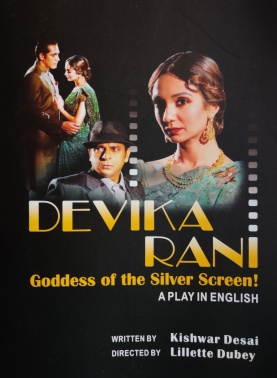 The play roughly covered around 18 years of Devika Rani’s life from 1926 to 1943- approximately from the time she met her husband Himanshu Rai to the last time she appeared on the silver screen as an actress. Lillette Dubey’s daughter Ira Dubey who reprises the role of Devika Rani comes up with a memorable performance and also does a fabulous job of singing the famous song – ‘Main ban ki chidiya ban ke ban ban dolun re…’.
The play roughly covered around 18 years of Devika Rani’s life from 1926 to 1943- approximately from the time she met her husband Himanshu Rai to the last time she appeared on the silver screen as an actress. Lillette Dubey’s daughter Ira Dubey who reprises the role of Devika Rani comes up with a memorable performance and also does a fabulous job of singing the famous song – ‘Main ban ki chidiya ban ke ban ban dolun re…’.
Apart from Ira the other artistes also acted very well. Joy Sengupta who played Himanshu Rai and Pranav Sachdev who played Ashok Kumar deserve a special mention for really looking and living their respective parts. The play was in English except for the dialogues of the Hindi films being enacted. The duration of the play was just 2 hours and it was a memorable evening indeed. Added bonus was watching the play in the august company of yesteryear actresses Waheeda Rehman, Asha Parekh and Helen who were seated in the audience and seemed to be enjoying the play just as much!
THE ETERNAL DIVA:
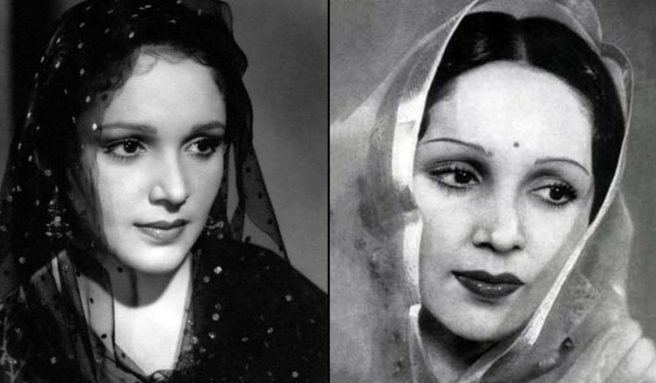
To understand the magic of Devika Rani who dominated the Indian film industry in the thirties and early forties, one has to understand her real-life and reel-life persona. Her charisma was not just about her being an actress. She had so many more talents and her aura continued even after she gave up acting and concentrated on being only the producer of Bombay Talkies.
REAL-LIFE PERSONA:
Multi-faceted, Bewitching & Ambitious
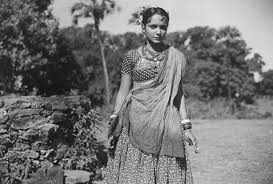 Stunningly beautiful and extraordinarily talented in various fields, Devika Rani was a pioneer in the truest sense of the word. Armed with a degree in acting, music, architecture, set-design and décor, she also had knowledge of various technical aspects of production, costume designing and make-up as well. Indeed she walked the path which no other actress before or after her has done including becoming the owner of a film studio in India- the prestigious Bombay Talkies. She played a major role in establishing the studio in partnership with her husband Himanshu Rai and with the help of their common friend Niranjan Pal (the son of nationalist leader Bipin Chandra Pal). The studio which was set up in Malad, Bombay, was equipped with the latest and technically advanced equipment and was built on the lines to match the top international studios of that time.
Stunningly beautiful and extraordinarily talented in various fields, Devika Rani was a pioneer in the truest sense of the word. Armed with a degree in acting, music, architecture, set-design and décor, she also had knowledge of various technical aspects of production, costume designing and make-up as well. Indeed she walked the path which no other actress before or after her has done including becoming the owner of a film studio in India- the prestigious Bombay Talkies. She played a major role in establishing the studio in partnership with her husband Himanshu Rai and with the help of their common friend Niranjan Pal (the son of nationalist leader Bipin Chandra Pal). The studio which was set up in Malad, Bombay, was equipped with the latest and technically advanced equipment and was built on the lines to match the top international studios of that time.
Behind that exquisitely beautiful face lay a strong woman who had the guts and gumption to challenge the male order in an era when women were afraid of stepping out to work and especially in the world of acting. Having being exposed to the European culture from a very young age, she was westernized in her thoughts and actions. She was a true feminist at a time when the term was probably not even coined properly! In fact she was among the first educated Indian women to enter this profession and her presence lent dignity and grace to the women in this field and the industry has a lot to be grateful to her for being the path-breaker.
Her personal life remained a colourful one throughout as she did not believe in treading the ‘conformed’ path a woman was supposed to lead and followed her heart in all the choices she made. She married Himanshu Rai-a man 16 years older to her, became a partner with him in starting a studio with world-class facilities, continued to be the studio’s head after her husband’s death, eloped with her hero Najam-Ul-Hassan during the shooting of her 2nd film while she was still married to Himanshu Rai, then realizing her mistake she came back and went on to become a top actress of her time, left acting to just remain a producer for a while and finally she left everything to get married to a Russian painter Svetoslav Roerich to settle for a quiet life first in the hills of Manali and later in their farmhouse in Bangalore.
Born on 30th March 1908 in the progressive Bengali family in Waltair, Andhra Pradesh, she was sent to study in London at the young age of nine. Her maternal great-grandmother Saudamini Devi and paternal grandmother Sukumari Devi were both Nobel laureate Rabindranath Tagore’s sisters. So she was related to Tagore from both sides. Her father Colonel (Dr) Manmathanath Chaudhury was the first Surgeon General of Madras Presidency. (http://members.iinet.net.au/~royalty/ips/families/tagore.html)
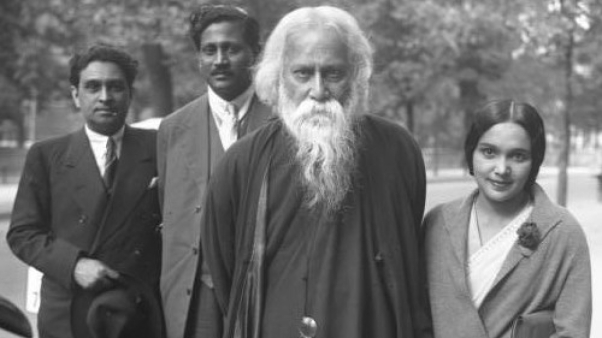
After finishing her schooling, she enrolled herself in the Royal Academy of Arts and Royal Academy of Music, London and got a degree in acting as well as singing. She always had an interest in the field of Arts and decided to take up a job in London as a textile engineer. While working in London, for a while Devika Rani stayed with Niranjan Pal, a writer for plays at that time, and his English wife Lily.
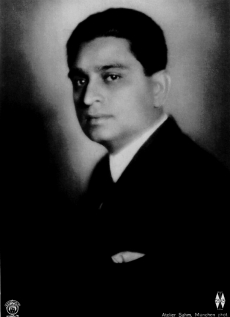
Interestingly, Himanshu Rai, who had already done a few stage plays in London and starred in the highly successful silent film Light of Asia in 1925 (based on the life of Buddha), was getting into film production at that time. He had acquired a name and was quite a well-known figure. He had also worked with Niranjan Pal in two of his plays and they knew each other. It was thus through this common friend that Devika Rani met Himanshu Rai. Little did they know that this chance encounter would end up changing not only their lives forever but also prove to be a game-changer for the film industry in India!
When Himanshu Rai was introduced to the young and multi-talented Devika Rani, he was totally besotted with her intelligence and charm and signed her to assist his production team in the costume and set-designing department for his upcoming film- A Throw of Dice in 1929. The two of were deeply in love and even though she had heard rumours of Himanshu being a womaniser, Devika Rani decided to get married to him. After this film they proceeded to Germany to get a better understanding of some more aspects of film making-production, camerawork and other technical aspects and also underwent training at the UFA (a German motion-picture production company) in Berlin.
Incidentally Lillete Dubey’s play throws light on some poignant aspects of her life. For instance when the premiere of their first film together-Karma had been held the Mable Arch Cinema, London the foreign media were very impressed with Devika Rani’s stunning beauty and acting but the same did not apply for her co-star and husband Himanshu Rai who did not like being side-lined and felt a little left out of the limelight.
The play also showed that Devika gets a shock when she comes to know of Himanshu’s first marriage to a German lady called Mary Heinlin and that he even had a daughter through her. He had hidden this part of his life from her and she was shattered emotionally. After this their personal relationship underwent a change and though they remained cordial to each other and proved to be excellent business partners doing everything they could to develop Bombay Talkies into a world-class studio, their marriage could never get back on track and their feelings could never be the same. Sadly he subjected her to physical abuse as well.
After coming to India the first film to be produced under the banner of Bombay Talkies was Jawani Ki Hawa which starred Devika Rani and a new hero Najam-Ul-Hassan. The film was a hit and they were signed for their next venture Jeevan Naiyya. It is said that during the making of this film they developed real feelings for each other and when only a few scenes of the film had been shot the two decided to elope leaving the producer and the unit in quandary. When one views this incident in the wake of how she had been shattered emotionally and mentally, it is not difficult to understand her reason for eloping with her on-screen hero.
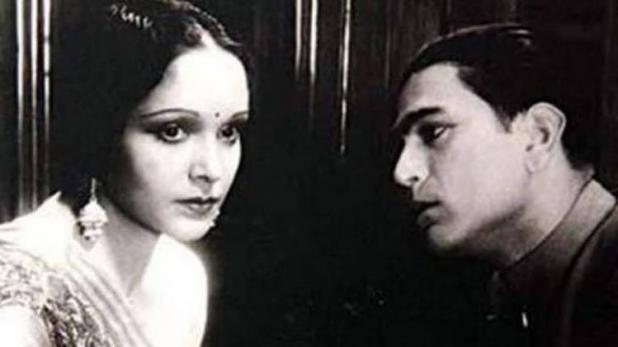
Having always lived life on her terms, Devika Rani did not care about what this step would do to her reputation both personally and professionally. But their common friend Shashadhar Mukherjee who worked as the sound engineer at Bombay Talkies intervened, found out where Devika had gone and managed to convince her not to throw away her career like this and also asked her to think of her dream of running Bombay Talkies.
Soon Devika Rani returned but the career of the hero Najam-Ul-Hassan had finished as Himanshu Rai refused to have him back in the film. In his place Shashadhar Mukherjee’s brother-in-law and friend Ashok Kumar was taken. Ashok Kumar at that time had been working in the technical department as an assistant. His earnest and handsome face, shy disposition, winning smile and his curly mop of hair won everybody’s vote. His name was changed from Kumudlal Ganguly to Ashok Kumar and thus Bombay Talkies gave to the industry its first superstar.
REEL-LIFE PERSONA:
Devika Rani’s entry into films coincided with the time the talkies were making inroads in the world of cinema. Right from her debut film Karma (1933) she found appreciation not only for her stunning looks but also her acting prowess. The film was the first English language talkie made by an Indian. With her superb English diction she wowed the foreign media who were completely bowled over by her performance and she was the cynosure of all attention at the film’s premiere. The film also made news for featuring a 4-minute long kissing scene!
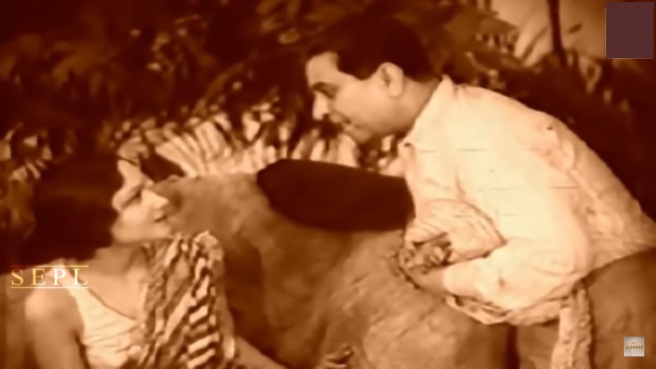
Bombay Talkies right from its inception tackled social dramas which resonated with the customs and traditions prevalent at that time in our society. Though Devika Rani acted in only 15-16 films in her ten-year long career she always tried to portray characters who had a progressive outlook and managed to impart strong messages through her roles. Most of the films were female-centric films where her character was central to the story. Her pairing with Ashok Kumar became very popular and together they starred in eight hit films- Jeevan Naiyya, Achchut Kanya, Savitri, Vachan, Izzat, Anjaan, Nirmala and Janmabhoomi.
In fact when the titles appeared in her films it was always ‘Bombay Talkies presents Devika Rani in…’. The names of other actors appeared only at the end after the names of the producer, director, and all technical artistes had appeared.
Some of her important films include:
ACHHUT KANYA (1935):
This is not only Devika Rani’s best film it is also considered a milestone in the history of Indian cinema. It was a touching love-story of a low-caste Harijan girl and an upper class Brahmin where the two childhood friends who had dreamt of a life together had to bow down to the pressures of caste system so deeply entrenched in the society at that time. The film shows the futility of these social evils which for senseless reasons raises objections to the union of two souls who love each other deeply. Excellent direction, compelling narrative and dialogues, melodious songs and a haunting performance by Devika Rani made the film immortal and is definitely a must-watch.
Here are two excellent songs from the film:
Song : ‘Main ban ki chidiya ban ke ban ban dolun re…’
Song: ‘Kit gaye ho khewanahaar…’
NIRMALA (1938)
This film has Devika Rani playing an educated girl who tops her class in studies and along with Ashok Kumar is tied in the first position. She joins college and wishes to continue her studies. But having promised a dying friend some years back, her parents want her to get her married to that friend’s son. As luck would have it she falls in love with Ashok Kumar and astrologers predict a very happy marriage for the two. However, everything starts going wrong starting from Ashok Kumar being kidnapped by the friend’s son and just manages to reach the venue on time. After that she has several miscarriages and is not able to conceive and she leaves the house without informing Ashok Kumar. Both face many obstacles before being reunited in old age. The film throws light upon the mindless belief in astrological practices and superstition. Both of them act very well.
Song: ‘Bolo sajani bolo…’
IZZAT (1937)
The film is a tragic love story and involves two ‘warring clans’, the Marathas and the Bhil tribe. After the kind head of the Marathas dies, he is succeeded by his evil nephew who commits atrocities on the tribes. Ashok Kumar and Devika Rani play the lovers. Circumstances turn the tribal Ashok Kumar into a bandit and when the evil nephew tries to molest his beloved Devika, he kills the nephew and is sentenced to death. Devika goes to meet him in jail and she also dies. It was an interesting plot and in a romantic scene between the lead pair, we can spot Ashok Kumar lying down with an exposed torso holding Devika’s hand!
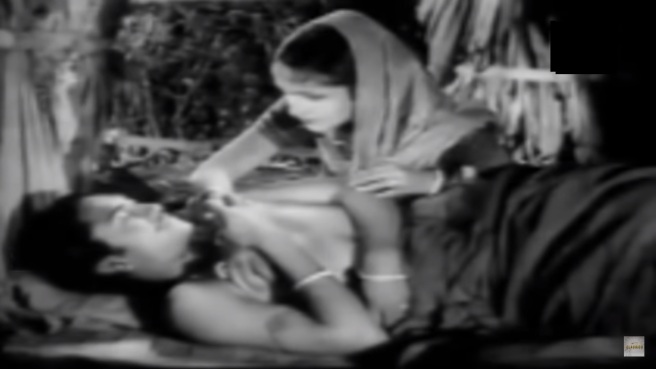
Song: ‘Matwaale nainon waale, ghungrale baalon waale…’
JEEVAN PRABHAT (1937)
The story is about remarriage and caste system. She plays a Brahmin girl but as she is not able to bear children she is sent away and her husband decides to remarry. Back in her home, she gets close to her childhood friend who belongs to a lower caste. Kishore Sahu and Mumtaz Ali play her husband and friend respectively.
ANJAAN (1941)
This is a love triangle between Ashok Kumar, Girish and Devika Rani. She plays a governess to the three children of a widow ’Ranima’. Both Ashok Kumar who is a doctor and also a guardian to the children and Girish who is the estate manager fall in love with her but Girish’s intentions are more evil. To remove his competitor from the path he kills Ranima and puts the blame on Ashok Kumar. After Himanshu Rai’s death, she returned to acting with this film and this was the last film she did with Ashok Kumar.
Song: ‘Mere jeevan path par cha gayi yeh kaun…’
Song: ‘Pyare pyare sapne hamaare…’
Song: ‘Main toh tumse bandhi rahoon…’
JANMABHOOMI (1938)
Ashok Kumar is a doctor and he and Devika are engaged to be married. But the death of his close friend changes Ashok Kumar’s mind and he decides to devote his life to serving the friend’s village and backs out of the marriage. Though disappointed Devika Rani does not lose heart and decides to join him as his co-worker in his quest for improving the backward mind-set of the villagers and educating them in scientific practices. Expectedly they face strong opposition and even get arrested on the charge of murder but everything works out fine in the end. The film throws light upon how one person can bring about a change in the society.
Song: ‘Yeh pyaari pyaari paati kiski…’
DURGA (1939):
Devika Rani plays an effervescent and tom-boyish character who is always up to tricks and gets away with all her pranks she plays on the villagers. Much to the chagrin of the village evil-mongers, they are never able to catch her red-handed and after her mother dies they hatch a plan to get her out of the village. They burn her house which forces her to go away and stay with a wealthy money lender who is a widower and has a small daughter. But she is not aware of his intentions to marry her. She not only manages to transform him but also makes him realize that her heart belongs to the village doctor played by actor Rama Shukul. The film is basically a social drama but gives her scope to showcase her bubbly self as a prankster.
Song: ‘Nadi paar hai aam ki bagiya…’
DEVIKA RANI & HER LEGACY
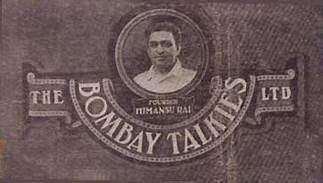
No write-up on Devika Rani is complete without writing about her tryst with Bombay Talkies. The world class studio that she established in 1934 in partnership with her husband Himanshu Rai had the latest equipment from Germany and the films they made not only met high technical standards, but were said to closely resemble the glossy movies being made by Hollywood’s MGM studio.
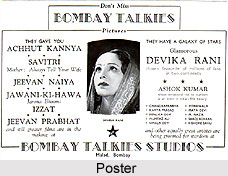
They had a loyal staff comprising of talented people like director Franz Osten, cameraman Joseph Wirsching,(both Germans), writer Niranjan Pal, dance director Mumtaz Ali, music director Saraswati Devi. There were other loyal staff members Shashadhar Mukherjee, Amiya Chakravorthy, etc. The quality of films, writing and direction were all world class.
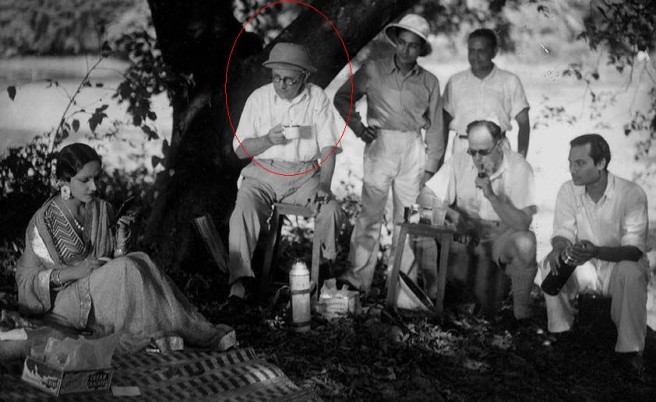
The studio is credited for introducing some great talents to the industry as is evident from the list of illustrious artistes who got a break. The careers of actors like Ashok Kumar, Dilip Kumar, Raj Kapoor, Madhubala, Kishore Sahu, Rajendranath, Mumtaz Ali (actor Mehmood’s father) and Leela Chitnis, directors like Franz Osten, Shashadhar Mukherjee, Amiya Chakravorthy and music director Saraswati Devi- all started with Bombay Talkies.
Devika Rani passed away on March 9th, 1994, one year after her husband Roerich died at their Bangalore farmhouse. She had no children from both her marriages to carry on her legacy. Today not many remember this great personality and even Bombay Talkies has faded away from our memory. Sadly in 2014 a fire broke out in a building in Borivali and that had housed many original prints of several films of Bombay Talkies- Achhut Kanya, Jhoola, and now they are lost forever. (https://www.hindustantimes.com/bollywood/achhut-kanya-bandhan-prints-destroyed-in-fire/story-6y2z5HFvq6wkq2O0HDHotK.html )
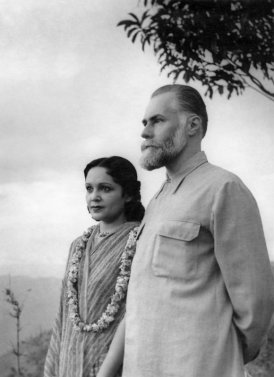
But the intelligent lady that she was she must have had a premonition of the ways of the industry and minds of the public which is probably why she had maintained a file of reviews, bills, photographs and film scripts of Bombay Talkies which are now a priceless source of connection to our industry’s past.After the studio shut down in 1954 when all the people associated with it had parted ways, Devika Rani kept all these materials with her and prior to her death she sent it to the curator of the Roerich Museum in New York, saying that “Someday someone may come looking for them.”
Ironically, today the owner of this prized collection of memorabilia is Peter Heitze- who happens to be none other than the grandson of the founder of Bombay Talkies-Himanshu Rai! He is the son of Himanshu Rai’s daughter Nilima through his German wife Mary. Though his mother had hidden the fact about his Indian ancestry, a chance finding of his grandfather Himanshu Rai’s photograph led him to know about the past and when he visited the Roerich Museum the curator was more than happy to hand over all the archives to him. Today he is the sole custodian of the priceless collection of Bombay Talkies archives. Here is the link to this interesting news on Peter Heitze. (https://www.bengaldaily.com/himanshu-rai-the-founder-of-the-bombay-talkies-studio-and-his-two-wives/)
For her immense contribution in the field of Indian cinema she was awarded the Padma Shri by the Government of India in 1958. She was also the first recipient of the prestigious Dadasaheb Phalke award-the country’s highest award for films, when it was instituted in 1969. In 1990, Soviet Russia honoured her with the ‘Soviet Land Nehru Award’. A commemorative stamp was also issued in her honour.
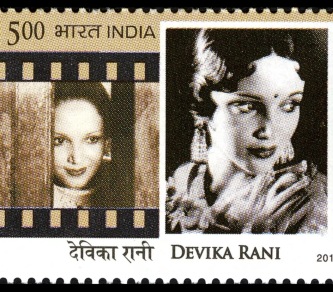





A priceless post…..thank you so much, Dr Bollywood. What a significant set of achievements in those times. Endeavours of our dream merchants these days simply pale in comparison to the kind of dedication, resourcefulness and risk-taking ability shown by her and Himanshu Rai in those days.
LikeLiked by 1 person
Thanks so much 🙂 🙏 Glad you enjoyed the post 🙂 🙂
LikeLiked by 1 person
Reblogged this on ashokbhatia.
LikeLike
An in-depth and fascinating write up. Sharada Iyer has offered an engrossing insight into the life and career of the evergreen actress.
LikeLiked by 1 person
Thank you so much Samban mama… 🙂
Great to read your feedback🙏
LikeLike
Fabulous & fascinating piece.
Just enthralled at the depth of research making it a compelling read.
Kudos to you for your extraordinary article. Awesome .
Brilliant article Shars.
Cheers & super show.
Keep penning these wonderful articles .
Shyamu
LikeLiked by 1 person
Thanks so much Shyamu…🌹🥰
LikeLike
Don’t know how I missed one of your most stupendously informative post. I am completely floored by the subject of the post as well as it’s writer. This valuable information must find its way into students’ curriculum. Every generation must know such a wonderful lady did us so proud and who better to highlight it than you, with your meticulous, painstaking and organized research and a compelling presentation. Brilliant
LikeLiked by 1 person
Thanks so much Mala for your kind words of appreciation. Thrilled to know you enjoyed the post🙏🏽…Indeed a remarkable lady with the well deserving title of First Lady of Indian Cinema… The films I saw she looks stunning and acts very well too.🌹
LikeLike
She is easily a definition of the word ‘Legend’ that can well be stated in an English dictionary describing the meaning of the term saying “Someone like Devika Rani!”
LikeLiked by 1 person